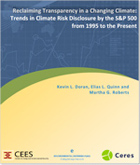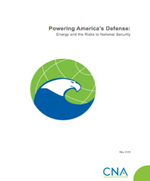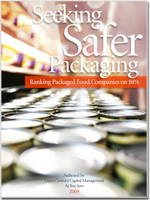Strategy
Learn which industries to compete in, how to allocate resources, and how to create value for shareholders.
Reclaiming Transparency in a Changing Climate
This report from Ceres, the Environmental Defense Fund and the Center for Energy and Environmental Security looks at how many -- or how few -- companies are reporting climate-related risks in their annual reports, and breaks down reporting on a sector-by-sector basis. Read More
GE’s 2008 Ecomagination Report
GE details the growth of its ecomagination portfolio to $17 billion in sales for 2008 as well as its progress toward a series of tough environmental performance goals. Read More
Powering America’s Defense: Energy and Risks to National Security
This report from a panel of retired U.S. military leaders concludes the country's current energy stance threatens the U.S. and its armed forces. Read More
Green Seal Standard for Restaurants Unveiled
Green lodging certifier Green Seal has extended its ecolabeling program to restaurants and foodservice establishments that reduce their environmental impacts, with a focus on responsible food purchasing and waste reduction. Read More
A Green-Jobs Move from Pure Capitalism to Natural Capitalism
Chris D'Avignon's green job story shows how the threads of work history, business skills, and a growing personal commitment to doing things better led him to build a business that is creating more green jobs daily. Read More
What's the Carbon Footprint of Your Toilet Paper?
Tesco is charging ahead with its plans to slap a carbon label on all of its private label products to denote the amount of greenhouse gas emissions it takes to produce each item. Next up: toilet paper and paper towels. Read More
Seeking Safer Packaging from Food Companies
This report from Green Century Capital Management and As You Sow looks at the ways that major packaged-foods companies are working to remove BPA from products, and grades them on their performance. Read More
The White Dog Cafe: A Study of Social Business and Mission-Aligned Exit
How can social businesses be scaled so that they maintain and enhance their mission after an IPO, acquisition, or any other transition? Judy Wicks, founder of White Dog Cafe, told her inspiring story at the Investors' Circle conference this week: The White Dog started as a coffee and muffin take-out shop on the first floor of her home and grew to a 200 seat restaurant and store with gross sales of $5M. Read More
How Companies Celebrate Earth Day
Companies large and small are taking Earth Day to heart, organizing events, outreach and education session for employees. We talked to more than a dozen companies across industries to find out what internal Earth Day activities they had lined up. Read More
Green IT: Why Mid-size Companies Are Investing Now
This research from IBM and Info-Tech Research looks at adoption rates of virtualization, power management, asset management and a host of other green IT practices in more than a thousand medium-sized companies. Read More




